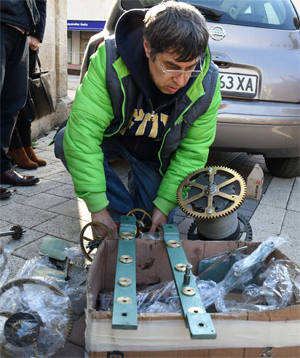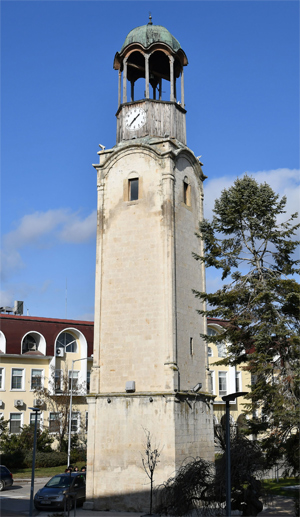One of the symbols of Bulgaria’s Razgrad - the city clock, has started measuring time again after nearly a two-year pause because of a malfunctioning mechanism. It took municipal administration a lot of time to find a specialist who was ready to repair the clock, preserving the authenticity of the mechanism. Most companies offered removing the parts of the 154-year-old clock and using digital equipment instead. According to experts the clock parts were worn out and in the past 25 years it was working only because of the great skills of local watchmakerIlkoKolev, who has been maintaining the clock.
 It was watchmaker from Sofia,Georgi Milchev, who took the difficult task of restoring the damaged parts of the old clock. He says the original mechanism was fully preserved with the exception of a few gears that were made especially for the clock. Most difficult was restoring the escapement mechanism. Here is more from the master craftsman:
It was watchmaker from Sofia,Georgi Milchev, who took the difficult task of restoring the damaged parts of the old clock. He says the original mechanism was fully preserved with the exception of a few gears that were made especially for the clock. Most difficult was restoring the escapement mechanism. Here is more from the master craftsman:
“The escapement mechanism is very important and provides better accuracy. The weight of the pendulum is exactly 1 kilogram. Regulator springs that ensure the smooth operation of the clock have been replaced, too. It is very difficult to repair such an old mechanism as it is easier to buy a new one.”
Georgi Milchev comes from a family involved in clock making and over the years has brought to life many old clocks, not only in Sofia but also in other Bulgarian cities and towns. When repairing the Razgrad clock, Milchev worked together with IlkoKolev and Alexander Manolev, who has experience in restoring museum exhibits.
 The Razgrad city clock was built in the 18th century and was reconstructed in the way it looks today in 1864 by TonchoTonchev who moved to Razgrad from the town of Triavna. The tower has interesting architecture because in some features it looks like a church. The tower consists of three parts as rectangular stone blocks were used for building the lower and the middle parts of the tower, which are separated by a cornice. The upper part of the tower is wooden octagonal structure with a dome. The height of the tower is a bit over 26 meters while the stone walls are 1-meter thick. Ivo Stoyanov, who is curator in the historic museum of Razgrad told Radio Bulgaria a curious story about the way craftsman TonchoTonchev started working on the tower.
The Razgrad city clock was built in the 18th century and was reconstructed in the way it looks today in 1864 by TonchoTonchev who moved to Razgrad from the town of Triavna. The tower has interesting architecture because in some features it looks like a church. The tower consists of three parts as rectangular stone blocks were used for building the lower and the middle parts of the tower, which are separated by a cornice. The upper part of the tower is wooden octagonal structure with a dome. The height of the tower is a bit over 26 meters while the stone walls are 1-meter thick. Ivo Stoyanov, who is curator in the historic museum of Razgrad told Radio Bulgaria a curious story about the way craftsman TonchoTonchev started working on the tower.
“He made a bet that he would built a clock tower in Razgrad with the local governor (pasha), whom according to Tonchev’s daughter, was renowned statesman and reformer Midhat Pasha. In case the governor did not like the tower, he could kill the master builder, but if he liked it he would then have to pay him a generous sum. The Pasha liked the work of the master and more than a century and a half later the tower keeps measuring time for the citizens and guests of Razgrad.”
English: Alexander Markov
Photos: BTAOn 3 March, Bulgaria celebrates the 147th anniversary of its liberation f rom five centuries of Ottoman rule. The day was declared a national holiday in 1990 by a decision of the National Assembly. The Treaty of San Stefano, signed on 19 February..
Today is Cheesefare Sunday. According to Orthodox tradition, this day is observed on the eve of Great Lent, when Christians seek and give forgiveness to each other . It is also known as Sirni Zagovezni because it marks the last day before Lent, when..
Priest Lyubomir Bratoev is a direct participant in the events of t he founding of the Bulgarian Orthodox Church community in Berlin . He came to the capital of East Germany in the late 1980s as a doctoral student. And, like a typical Orthodox Christian..
30 March marks the end of the most blessed time of the year, as Muslims call the month of Ramadan. This year it started on 1 March, and the most..

+359 2 9336 661
